What the Block
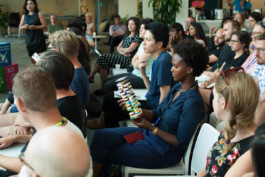
Project Details
Year
2018 - Ongoing
Role
Founder
Researcher
Concept creation
Game design
Education design
Selected Clients
Copenhagen Institute of Interaction Design
Dare Disrupt
TechFestival
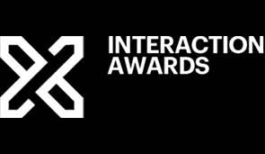



What The Block is a project which aims to engage people through gamification, in order to distribute knowledge and unlock the potential of Blockchain.
In just 4 rounds of learning through play, participants understand all of the core features of Blockchain, are able to take part in open constructive dialogue, and start to imagine ideas that utilise the potential of distributed ledger technologies.
As a designer working with Blockchain across several intersections, and particularly the topic of possible future applications of emerging technologies, I am passionate about exploring the role that narrative driven experiences and formats can play in delivering effective learning.
Through the design and development of an interactive, physical game, What The Block seeks to deliver a solid understanding of theoretical and conceptual notions of Blockchain, as well as inspire imaginative use cases of Blockchain technology, to derive ideas for applications to be deployed in the future.
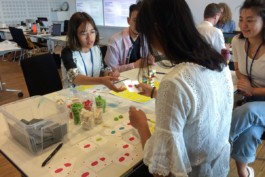
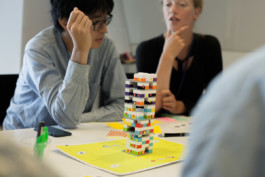
How can we make Blockchain more Human?
A smart contract created by participants results in a group 'wave'
What The Block is a project which is all about engaging people through design, to learn and discover the potential of new technologies. I started out with Blockchain, since as a designer working with Blockchain, I had been inundated with requests from colleagues, peers, clients, family and friends to explain Blockchain – the problem was I couldn’t find any good existing material out there.
Through research I realised that many people were frustrated with trying to understand what Blockchain is, and had a poor understanding of what it could be used for. Since mass adoption of the technology is some way away, and there are few opportunities to really use it in everyday life, I oriented the game on trying to quickly address the basics of what Blockchain is, before moving on to the more difficult task of allowing people to create their own concepts.
The approach was to create an analog game format which inspires curiosity and allows people to learn without any prerequisite knowledge, in a fun and fast-paced manner. Through top-down learning, What The Block immerses participants in the world of Blockchain, builds their vocabulary and knowledge, and allows them to start asking relevant and insightful questions, which often evolves into a group discussion. This is facilitated by a trained team, using tools and materials like lectures, slides and stories to reinforce knowledge.
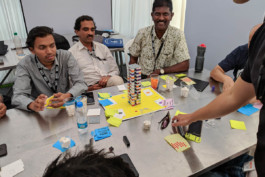
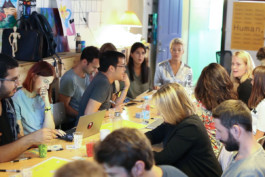
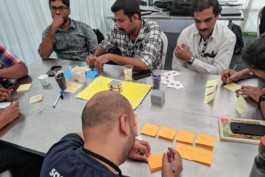
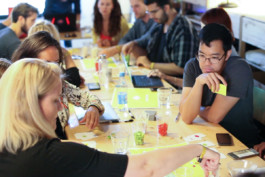
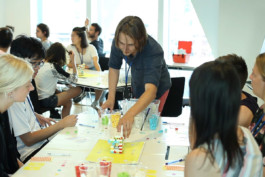
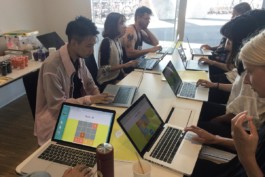
Participants in Kochi, India
What The Block at TechFestival
Participants devising Tokens to trade
What The Block gameplay
Game facilitation by John Ferreira
'Mining' side game
Development of the game was inspired by various works, including Storyblocks (Maxwell, 2016), an excellent example of narrative led explanations of Blockchain, again using analog tools and references. Building upon key references, myself and John Ferreira began to sketch notions of a game, which would incorporate physical objects to represent the digital features and metaphors of Blockchain such as tokens, mining and smart contracts.
Through rapid prototyping and internal testing of ideas, we developed an initial game using coloured Lego blocks to represent tokens, and a central ledger plate to represent the Blockchain. We recruited masters students from the Copenhagen Institute of Interaction Design to take part in a workshop to test the concept. Participants were asked to trade Lego blocks with one another and record their trades on the Blockchain, using stickers to record the direction of interactions.
Following prototyping, we eventually settled on a game format, based around a simple trading game, evolving over the rounds, with participants gradually accumulating knowledge, which they can apply in later rounds. Game elements such as cards and Lego blocks are used throughout the game. The full set of cards includes resource cards, round objective cards, overall game objective cards, scenario cards, and smart contract cards that could be used to detail the rules of a smart contract.

What The Block game elements

What The Block game board
The game is played using a board, which becomes a hub of activity; a system where socioeconomic interactions occur, rules and conditions are defined, and relationships are built. All exchanges of value that occur in the game are recorded on a central Lego plate, which eventually forms a Lego Blockchain.
The game inspires curiosity and allows people to learn without any prerequisite knowledge, in a fun and fast-paced manner. This is enabled through a technique known as top-down learning — immersing participants in the world of Blockchain, building their knowledge, and allowing them to start asking relevant and insightful questions. Typically, this evolves into a
facilitated group discussion, using tools like slides, stories and examples to reinforce knowledge and develop a precise technical vocabulary.
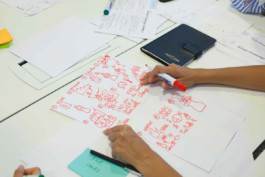
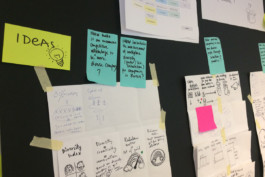
The workshops range from half a day to five day sessions. While shorter formats focus on Blockchain alone, in longer sessions, participants go through a bespoke design process created by What The Block. Tasked with a design challenge, they conduct research, craft insights and opportunity areas, ideate, prototype and iterate. This helps them to develop robust concepts, and put into practice the knowledge they gain from the early part of the workshop, namely the key features of Blockchain – facilitating value transfer, in transparent systems, where trust is a feature.
Working with clients, to date, more than 500 people have played the game and developed an understanding of Blockchain preparing them for a post-money future. We’ve heard from many people who had struggled for months trying to grasp even the basics of Blockchain, but through playing the What The Block game, in just a few hours, could not only understand what Blockchain is, but could begin to craft their own concepts.
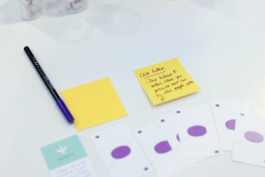

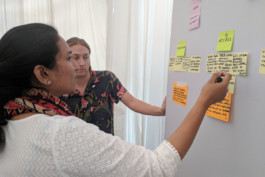
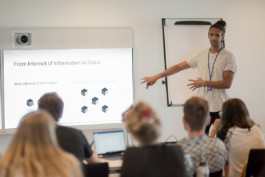
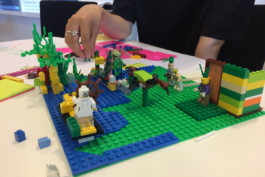
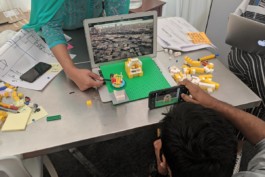
Following on from the game, participants use cards to ideate
We go through a bespoke design process
We go through a bespoke design process
Adding Blockchain theory throughout
In line with using physical tools, we use Lego for rapid prototyping
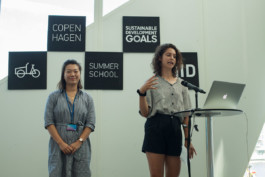
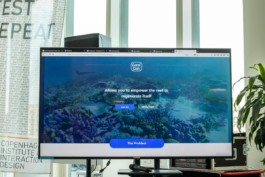
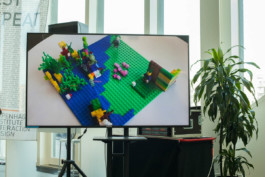

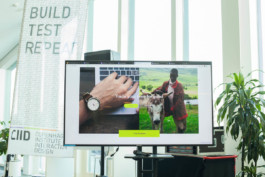
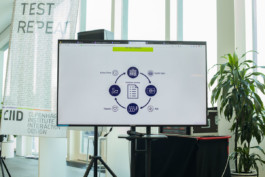
Participants presenting concepts at the UN 2018
'Coral Coin' Concept
'Coral Coin' Prototype video
Participants presenting at UN Copenhagen 2018
'Earth Wallet' Concept
'Earth Wallet' system design diagram
Many of our workshop participants work within NGOs or large public sector organizations and they’ve told us that our approach has helped them uncover a world of new opportunities. To date participants have crafted ideas ranging from identification systems for Syrian refugees at the Lebanese border, to Coral Coin, a smart contract based auto-governance for coral reefs
At its heart, What The Block is all about using design to engage with people’s pure curiosity, to demystify a topic which many have found confusing, using a fresh and accessible approach for learning, which has yielded great results. Furthermore, the opportunity to extend this gamified approach to learning, to other emerging disciplines from artificial intelligence to biotech is evident.
Project Credits
Created by
Cyrus Clarke
Graphic Design
John Ferreira
Recognition
Core77 (2019)
Interaction (2019)
Selected Clients
Copenhagen Institute of Interaction Design (CIID)
Danish Engineers Association (IDA)
Dare Disrupt
Founders of Tomorrow
TechFestival
What the Block

Project Details
Year
2018 - Ongoing
Role
Founder
Concept creation
Game Design
Education Design
Selected Clients
CIID
Dare Disrupt
TechFestival


What The Block is a project which aims to engage people through gamification, in order to distribute knowledge and unlock the potential of Blockchain.
In just 4 rounds of learning through play, participants understand all of the core features of Blockchain, are able to take part in open constructive dialogue, and start to imagine ideas that utilise the potential of distributed ledger technologies.
As a designer working with Blockchain across several intersections, and particularly the topic of possible future applications of emerging technologies, I am passionate about exploring the role that narrative driven experiences and formats can play in delivering effective learning.
Through the design and development of an interactive, physical game, What The Block seeks to deliver a solid understanding of theoretical and conceptual notions of Blockchain, as well as inspire imaginative use cases of Blockchain technology, to derive ideas for applications to be deployed in the future.







Participants in Kochi, India
What The Block at TechFestival
Participants devising Tokens to trade
What The Block gameplay
Game facilitation by John Ferreira
'Mining' side game
How can we make Blockchain more Human?
What The Block is a project which is all about engaging people through design, to learn and discover the potential of new technologies. I started out with Blockchain, since as a designer working with Blockchain, I had been inundated with requests from colleagues, peers, clients, family and friends to explain Blockchain – the problem was I couldn’t find any good existing material out there.
Through research I realised that many people were frustrated with trying to understand what Blockchain is, and had a poor understanding of what it could be used for. Since mass adoption of the technology is some way away, and there are few opportunities to really use it in everyday life, I oriented the game on trying to quickly address the basics of what Blockchain is, before moving on to the more difficult task of allowing people to create their own concepts.
The approach was to create an analog game format which inspires curiosity and allows people to learn without any prerequisite knowledge, in a fun and fast-paced manner. Through top-down learning, What The Block immerses participants in the world of Blockchain, builds their vocabulary and knowledge, and allows them to start asking relevant and insightful questions, which often evolves into a group discussion. This is facilitated by a trained team, using tools and materials like lectures, slides and stories to reinforce knowledge.

What The Block game board

What The Block game elements
Development of the game was inspired by various works, including Storyblocks (Maxwell, 2016), an excellent example of narrative led explanations of Blockchain, again using analog tools and references. Building upon key references, myself and John Ferreira began to sketch notions of a game, which would incorporate physical objects to represent the digital features and metaphors of Blockchain such as tokens, mining and smart contracts.
Through rapid prototyping and internal testing of ideas, we developed an initial game using coloured Lego blocks to represent tokens, and a central ledger plate to represent the Blockchain. We recruited masters students from the Copenhagen Institute of Interaction Design to take part in a workshop to test the concept. Participants were asked to trade Lego blocks with one another and record their trades on the Blockchain, using stickers to record the direction of interactions.
Following prototyping, we eventually settled on a game format, based around a simple trading game, evolving over the rounds, with participants gradually accumulating knowledge, which they can apply in later rounds. Game elements such as cards and Lego blocks are used throughout the game. The full set of cards includes resource cards, round objective cards, overall game objective cards, scenario cards, and smart contract cards that could be used to detail the rules of a smart contract.


The workshops range from half a day to five day sessions. While shorter formats focus on Blockchain alone, in longer sessions, participants go through a bespoke design process created by What The Block. Tasked with a design challenge, they conduct research, craft insights and opportunity areas, ideate, prototype and iterate. This helps them to develop robust concepts, and put into practice the knowledge they gain from the early part of the workshop, namely the key features of Blockchain – facilitating value transfer, in transparent systems, where trust is a feature.
Working with clients, to date, more than 500 people have played the game and developed an understanding of Blockchain preparing them for a post-money future. We’ve heard from many people who had struggled for months trying to grasp even the basics of Blockchain, but through playing the What The Block game, in just a few hours, could not only understand what Blockchain is, but could begin to craft their own concepts.







Many of our workshop participants work within NGOs or large public sector organizations and they’ve told us that our approach has helped them uncover a world of new opportunities. To date participants have crafted ideas ranging from identification systems for Syrian refugees at the Lebanese border, to Coral Coin, a smart contract based auto-governance for coral reefs
At its heart, What The Block is all about using design to engage with people’s pure curiosity, to demystify a topic which many have found confusing, using a fresh and accessible approach for learning, which has yielded great results. Furthermore, the opportunity to extend this gamified approach to learning, to other emerging disciplines from artificial intelligence to biotech is evident.
Project Credits
Created by
Cyrus Clarke
Graphic Design
John Ferreira
Recognition


Clients and Workshops
Maritime Disruption Academy
Dare Disrupt
Danish Engineers Association
Founders of Tomorrow
CIID Summer School, Copenhagen
CIID Summer School, Kochi
Techfestival (2018)
Impact
What the Block has been played by more than 500 participants since its launch in 2018, bringing Blockchain technology to the general public.
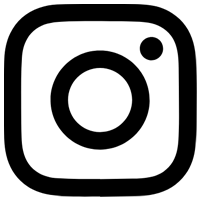

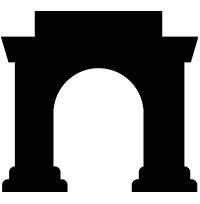
© Cyrus Clarke 2025